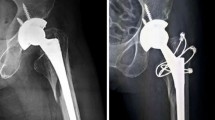Abstract
Purpose
Hip arthroplasty is rarely indicated in the treatment of per- and intertrochanteric femur fractures. Although the majority of fractures are amenable to closed- or open reduction and internal fixation (CRIF/ORIF), in some patients the complexity of the fracture or other patient-related factors may cause the orthopaedic surgeon to consider arthroplasty as the treatment of choice. Decision-making is challenging, and a reliable score has not yet been established.
Results
Reviewing literature, several predictors of inferior outcome after CRIF/ORIF in per- and intertrochanteric fractures such as age, gender, poor bone quality, hip osteoarthritis, operation time and postoperative weight-bearing restrictions have been identified. Based on the literature review, a novel Hamburg Per- and Intertrochanteric Fracture Score (HPIFS) is proposed to support decision-making for per- and intertrochanteric fracture treatment.
Conclusions
CRIF/ORIF remain the workhorses in per- and intertrochanteric fracture management. Arthroplasty offers an advantageous treatment option for a well-defined patient and fracture collective. The HPIFS might support the decision-making process.



Similar content being viewed by others
References
Grimsrud C, Monzon RJ, Richman J, Ries MD. Cemented hip arthroplasty with a novel cerclage cable technique for unstable intertrochanteric hip fractures. J Arthroplasty. 2005;20(3):337–43.
Zuckerman JD. Hip fractures. N Engl J Med. 1996;334:1519.
Chan KC, Gill GS. Cemented hemiarthroplasties for elderly patients with intertrochanteric fractures. Clin Orthop Relat Res. 2000;371:206.
Kyle RF, Gustillo RB, Premer RF. Analysis of six hundred and twenty-two intertrochanteric hip fractures. J Bone J Surg. 1979;61-A:216.
Mariani EM, Rand JA. Nonunion of intertrochanteric fractures of the femur following open reduction and internal fixation. Clin Orthop Relat Res. 1987;218:81.
Lu-Yao G, Keller R, Littenberg B. Outcomes after displaced fractures of the femoral neck. A metaanalysis of 106 published reports. J Bone J Surg. 1994;76A:15.
Hardy DCR, et al. Use of an intramedullary hip-screw compared with a compression hip-screw with a plate for intertrochanteric femoral fractures: a prospective, randomized study of one hundred patients. J Bone Joint Surg. 1998;80:618.
Haentjens P, et al. Treatment of unstable intertrochanteric and subtrochanteric fractures in elderly patients. J Bone Jonit Surg. 1989;71-A:1214.
Jones HW, Johnston P, Parker M. Are short femoral nails superior to the sliding hip screw? A meta-analysis of 24 studies involving 3,279 fractures. Int Orthop. 2006;30:69–78.
Nuber S, Schonweiss T, Ruter A. Stabilisation of unstable trochanteric femoral fractures. Dynamic hip screw (DHS) with trochanteric stabilisation plate vs. proximal femur nail (PFN). Unfallchirurg. 2003;106:39–47.
Saudan M, Lubbeke A, Sadowski C, Riand N, Stern R, HoVmeyer P. Pertrochanteric fractures: is there an advantage to an intramedullary nail?: a randomized, prospective study of 206 patients comparing the dynamic hip screw and proximal femoral nail. J Orthop Trauma. 2002;16:386–93.
Utrilla AL, Reig JS, Munoz FM, Tufanisco CB. Trochanteric gamma nail and compression hip screw for trochanteric fractures: a randomized, prospective, comparative study in 210 elderly patients with a new design of the gamma nail. J Orthop Trauma. 2005;19:229–33.
Geiger F, Zimmermann-Stenzel M, Heisel C, Lehner B, Daecke W. Trochanteric fractures in the elderly: the influence of primary hip arthroplasty on 1-year mortality. Arch Orthop Trauma Surg. 2007;127(10):959–66.
Kim SY, Kim YG, Hwang JK. Cementless calcar-replacement hemiarthroplasty compared with intramedullary fixation of unstable intertrochanteric fractures: a prospective, randomized study. J Bone Joint Surg Am. 2005;87(10):2186–92.
Calvert PT. The gamma nail: a significant advance or passing fancy? J Bone Joint Surg. 1992;74-B:329.
Bridle SH, Bircher M, Calvert PT. Fixation of intertrochanteric fractures of the femur: a randomised prospective comparison of the gamma nail and the dynamic hip screw. J Bone Joint Surg. 1991;73-B:330.
Broos PL, Willemsen PJ, Rommens PM, Stappaerts KH, Gruwez JA. Pertrochanteric fractures in elderly patients: treatment with a long-stem/long-neck endoprosthesis. Unfallchirurg. 1989;92:234–9.
Rodop O, Kiral A, Kaplan H, Akmaz I. Primary bipolar hemiprosthesis for unstable intertrochanteric fractures. Int Orthop. 2002;26:233–7.
Geiger F, Schreiner K, Schneider S, Pauschert R, Thomsen M. Proximal fracture of the femur in elderly patients: the influence of surgical care and patient characteristics on post-operative mortality. Orthopade. 2006;35(6):651–7.
Andress HJ, Kahl S, Kranz C, Gierer P, Schürmann M, Lob G. Clinical and finite element analysis of a modular femoral prosthesis consisting of a head and stem component in the treatment of pertrochanteric fractures. J Orthop Trauma. 2000;14(8):546–53.
Dobbs RE, Parvizi J, Lewallen DG. Perioperative morbidity and 30-day mortality after intertrochanteric hip fractures treated by internal fixation or arthroplasty. J Arthroplasty. 2005;20(8):963–6.
Asayama I, Chamnongkich S, Simpson KJ, Kinsey TL, Mahoney OM. Reconstructed hip joint position and abductor muscle strength after total hip arthroplasty. J Arthroplasty. 2005;20(4):414–20.
Steinberg B, Harris WH. The doffsetT problem in total hip arthroplasty. Contemp Orthop. 1992;24:556.
Mabry TM, Prpa B, Haidukewych GJ, Harmsen WS, Berry DJ. Long-term results of total hip arthroplasty for femoral neck fracture nonunion. J Bone Joint Surg Am. 2004;86-A:2263–7.
Conflict of interest
M. Hoffmann, M. Hartel, J. M. Rueger and W. Lehmann declare that they have no conflict of interest.
Ethical standard
The manuscript does not contain clinical studies performed by any of the authors or patient data.
Author information
Authors and Affiliations
Corresponding author
Rights and permissions
About this article
Cite this article
Hoffmann, M., Hartel, M., Rueger, J.M. et al. Primary prosthetic replacement in per- and intertrochanteric fractures. Eur J Trauma Emerg Surg 40, 273–277 (2014). https://doi.org/10.1007/s00068-014-0412-9
Received:
Accepted:
Published:
Issue Date:
DOI: https://doi.org/10.1007/s00068-014-0412-9




